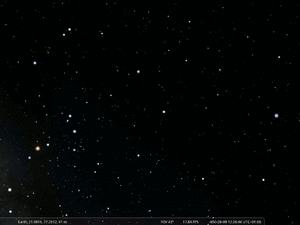Vishakha: Difference between revisions
No edit summary |
No edit summary |
||
| Line 2: | Line 2: | ||
[[File:16 Vishakha draw.png|thumb|Vishakha, the 16th nakshatra, as depicted in temples.]] |
[[File:16 Vishakha draw.png|thumb|Vishakha, the 16th nakshatra, as depicted in temples.]] |
||
[[File:16 Vishakha stellarium.gif|thumb|Vishakha, the 16th nakshatra, mapped to the Stellarium star chart (WGSN 2025).]] |
[[File:16 Vishakha stellarium.gif|thumb|Vishakha, the 16th nakshatra, mapped to the Stellarium star chart (WGSN 2025).]] |
||
Viśākhā (विशाखा), "forked", is an Indian name, used by the Indian Vedic tradition. Most of these names are roughly 3000 years old. They pre-date Hinduism but were taken over by it. |
Viśākhā (विशाखा), "forked", is an Indian name, used by the Indian Vedic tradition. Most of these names are roughly 3000 years old. They pre-date Hinduism but were taken over by it. Identified with α, β, γ and ι Librae. |
||
==Etymology and History== |
==Etymology and History== |
||
Revision as of 07:06, 14 October 2025
Viśākhā (विशाखा), "forked", is an Indian name, used by the Indian Vedic tradition. Most of these names are roughly 3000 years old. They pre-date Hinduism but were taken over by it. Identified with α, β, γ and ι Librae.
Etymology and History
Name Variants
- Viśākhā,
- Vishakha
- Dvidaivata
Origin of Constellation
The name "Vishakha" means "having many branches" which is depicted in the temple drawing. Yet, the asterism has only four stars among which two are α and β Librae which is known from coordinates. The other two are typically identified with ι and γ Lib. These four stars do not form a line but a quadrilateral in the sky. It is outside the band of the Milky Way. Therefore, the literal translation may not refer to any recognizable pattern (of stars or bright or dark clouds of the Milky Way).
Transfer and Transformation of the Constellation
Mythology
mnemonic tales and cultural significance
Weblinks
References
- References (general)







